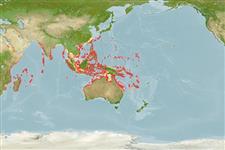Environment: milieu / climate zone / depth range / distribution range
экология
морской ассоциированный с рифами; немигрирующий; пределы глубины 1 - 35 m (Ref. 90102). Tropical; 30°N - 24°S, 114°E - 171°E
Indo-Pacific: East Africa south to Maputo, Mozambique (Ref. 4421) and east to Samoa, north to Ryukyu Islands, south to the southern Great Barrier Reef, New Caledonia, and Tonga. Replaced by Oxymonacanthus halli in the Red Sea.
Size / Вес / Возраст
Maturity: Lm ? range ? - ? cm
Max length : 12.0 cm TL самец/пол неопределен; (Ref. 9710)
Краткое описание
определительные ключи | морфология | морфометрия
колючие лучи спинного плавника (общее число) : 2; членистые (мягкие) лучи спинного плавника (общее число) : 31 - 35; колючие лучи анального плавника: 0; членистые (мягкие) лучи анального плавника: 29 - 32. Ventral rudiment absent; bristles on caudal peduncle of males longer than others on body (Ref. 37816).
Occurs in clear lagoon and seaward reefs from 0.5 to at least 30 m. Found in pairs or small groups and nests near bases of dead corals, often on clumps of algae. Monogamous (Ref. 52884, 48637). Feeds exclusively on Acropora polyps. Feeding takes place throughout the day becoming less towards the evening (Ref. 46144).
Life cycle and mating behavior
половая зрелость | размножение | нерест | икра | Fecundity | личинки
Aggression is used commonly in courtship. Spawning commences when after swimming together in different tufts, the female concentrates on just one and begins to thrust repeatedly and pause. The male follows suit nuzzling the female. The female then drops into the algae and spawns, while the male releases the sperm beside her. The pair then swims back to their territory (Ref. 46144). Monogamous mating is observed as both facultative and social (Ref. 52884).
Myers, R.F., 1991. Micronesian reef fishes. Second Ed. Coral Graphics, Barrigada, Guam. 298 p. (Ref. 1602)
Статус Красного Списка МСОП (Ref. 130435: Version 2024-2)
Угроза для людей
Harmless
Использование человеком
рыболовство: интереса не представляет; аквариум: коммерческий
дополнительная информация
инструменты
Специальные отчеты
Скачать в формате XML
ресурсы в Интернет
Estimates based on models
Preferred temperature (Ref.
123201): 25 - 29.3, mean 28.4 °C (based on 2439 cells).
Phylogenetic diversity index (Ref.
82804): PD
50 = 0.7500 [Uniqueness, from 0.5 = low to 2.0 = high].
Bayesian length-weight: a=0.01995 (0.00956 - 0.04164), b=2.93 (2.76 - 3.10), in cm total length, based on LWR estimates for this (Sub)family-body shape (Ref.
93245).
Trophic level (Ref.
69278): 3.3 ±0.6 se; based on diet studies.
устойчивость к внешним воздействиям (Ref.
120179): средний (среднего размера), минимальное время удвоения популяции 1.4-4.4 года (Fec = 200).
Fishing Vulnerability (Ref.
59153): Low vulnerability (10 of 100).
Nutrients (Ref.
124155): Calcium = 79.6 [34.6, 217.9] mg/100g; Iron = 0.822 [0.365, 1.964] mg/100g; Protein = 18.1 [15.8, 20.3] %; Omega3 = 0.121 [0.056, 0.249] g/100g; Selenium = 28.3 [13.4, 65.1] μg/100g; VitaminA = 79.6 [22.6, 288.7] μg/100g; Zinc = 1.51 [0.97, 2.44] mg/100g (wet weight);
